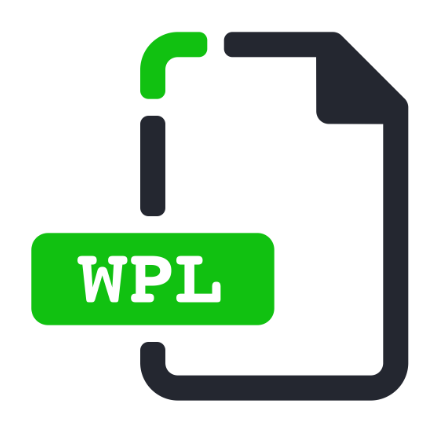.WPL File Extension

Windows Media Player Playlist
| Developer | Microsoft |
| Popularity | |
| Category | Video Files |
| Format | .WPL |
| Cross Platform | Update Soon |
What is an WPL file?
.WPL file extension stands for Windows Media Player Playlist, a format developed by Microsoft. These files are used to store multimedia playlists, essentially a list of digital media files and their locations.
.WPL playlists are XML-based, making them easily editable with a text editor, yet they are specifically designed for compatibility with Windows Media Player (WMP), one of the most widely used media players in the Windows operating system ecosystem.
More Information.
The purpose of the WPL file was to provide Windows users with a simple way to organize and play a collection of multimedia files without needing to manually open each file.
By creating playlists, users could compile their favorite songs, videos, or a mix of both into a single file that Windows Media Player could recognize and play sequentially or in a shuffled order.
This convenience was a significant step forward in personal media management at the time, reflecting the digital era’s burgeoning growth.
Origin Of This File.
The .WPL format was introduced alongside Windows Media Player 9 Series, marking Microsoft’s foray into more advanced multimedia management within its operating systems.
The introduction of WPL was part of Microsoft’s broader effort to enhance the multimedia experience on Windows, catering to the growing demand for digital media consumption, organization, and management.
File Structure Technical Specification.
.WPL files are structured in XML format, which stands for Extensible Markup Language. XML is a flexible way to create information formats and electronically share structured data via the public Internet, as well as via corporate networks.
A WPL file consists of a header that declares it as an XML document and a series of elements and attributes that define the playlist’s properties and the media items it contains.
The structure includes elements such as <smil>, <body>, and <seq>, which outlines the playlist’s layout. Inside these elements, <media> tags are used to specify individual media files, including attributes for the source (src) of the file, which is typically a path to the file’s location on the user’s system or network.
How to Convert the File?
Converting WPL files to other playlist formats (e.g., M3U) can enhance their compatibility across different media players and operating systems.
This can typically be done using media player software that supports both WPL and the target format or through online conversion tools designed for playlist files.
- Using Media Player Software: Some media players and media library management applications can import WPL playlists and export them in other formats. To convert, load the WPL file into the application, then use the export or “Save As” feature to choose the desired format.
- Online Conversion Tools: Some websites offer free file conversion services, including for playlist files. These require uploading the WPL file and selecting the format you wish to convert it to.
Advantages And Disadvantages.
Advantages:
- Compatibility: WPL files are natively supported by Windows Media Player, ensuring seamless integration with the Windows operating system.
- Editability: Being XML-based, WPL files can be easily edited with a text editor, allowing users to modify playlists without opening Windows Media Player.
- Flexibility: Users can include a variety of media types in a single playlist, from audio to video files, catering to diverse multimedia needs.
Disadvantages:
- Limited Compatibility Outside Windows: WPL files are optimized for Windows Media Player, which can limit their usability on non-Windows platforms or other media players.
- Dependence on File Paths: Since WPL playlists reference media files by their paths, moving files to different locations can break the playlist unless the paths are updated.
- Lack of Universal Support: Unlike more universally accepted formats like M3U, WPL’s compatibility is mainly restricted to Windows Media Player, which might not be the preferred choice for all users.
How to Open WPL?
Open In Windows
- Windows Media Player: Double-clicking a WPL file in Windows will typically open it in Windows Media Player by default. Alternatively, you can open WMP and use the File > Open menu to select the WPL file manually.
Open In Linux
- Third-Party Media Players: Like macOS, Linux users can rely on media players that support WPL files or can convert WPL to a more universally accepted format. VLC Media Player, for instance, is a versatile option that runs on Linux and supports a wide range of formats.
- Manual Conversion: Linux users comfortable with scripting can manually convert WPL files to M3U using text editors and command-line tools.
Open In MAC
- Conversion Required: Since WPL files are not natively supported on macOS, converting them to a compatible format like M3U is necessary. After conversion, playlists can be opened with iTunes or other macOS-compatible media players.
- Third-Party Media Players: Some third-party media players for macOS might offer limited support for WPL files or provide conversion tools within the application.
Open In Android
Open In IOS
Open in Others
- Mobile Media Players: While native support for WPL files on Android and iOS is rare, some mobile media player apps might offer the ability to import and convert WPL playlists for use within the app.
- Cloud-Based Media Libraries: Uploading media files to a cloud-based service that offers playlist management can be another way to access the content of WPL files on mobile devices, albeit indirectly.












